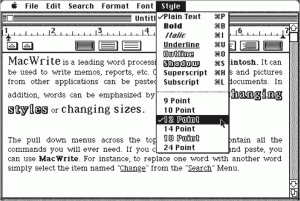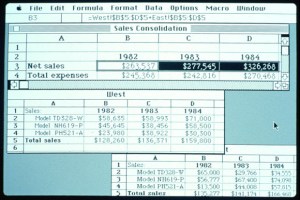Posts Tagged ‘career’
Why was 1984 not really like “1984”, for me
 For me, 1984 was the year of Van Halen’s wonderful [sic] album, The Right Stuff, and my second semester of college. It would also prove to be a time of enlightenment for me and computing. On this 30th anniversary of the Apple Macintosh on January 25 and the Superbowl commercial on January 22. I wanted to share my own story of the way the introduction of the Macintosh profoundly changed my path in life.
For me, 1984 was the year of Van Halen’s wonderful [sic] album, The Right Stuff, and my second semester of college. It would also prove to be a time of enlightenment for me and computing. On this 30th anniversary of the Apple Macintosh on January 25 and the Superbowl commercial on January 22. I wanted to share my own story of the way the introduction of the Macintosh profoundly changed my path in life.
Perhaps a bit indulgent, bit it seemed worth a little backstory. I think everyone from back then is feeling a bit of nostalgia over the anniversary of the commercial, the product, and what was created.
High School, pre-Macintosh
Like many Dungeons and Dragons players my age, my first exposure to post-Pong computing was an Atari 800 that my best friend was lucky enough to have (our high school was not one to have an Apple ][ which hadn’t really made it to suburban Orlando). While my friends were busy listening to the Talking Heads, Police, and B-52s, I was busy teaching myself to program on the Atari. Even though it had the 8K BASIC cartridge it lacked tape storage. Every time I went over to use the computer I had to start over. Thinking about business at an early age (I suppose) I would continue to code and refine what I thought would be a useful program for our family business, the ability to compute sales tax on purchases from different states. Enter the total sale, compute the sales tax for a state by looking up the rate in a table.
My father, an entrepreneur but hardly a technologist, was looking to buy a computer to “automate” our family business. In 1981, he characteristically dove head first into computing and bought an Osborne I. For a significant amount of money ($1,795, or $4,600 today) we owned an 8 bit CPU and two 90K floppy drives and all (five) of the business programs one could ever need.
I started to write a whole business suite for the business (inventory, customers, orders) in BASIC which is what my father had hoped I would conjure up (in between SATs and college prep). Well that was a lot harder than I thought it would be (so were the SATs). Then I discovered dBase II and something called a “database” that made little sense to me in the abstract (and would only come to mean something much later in my education). In a short time I was able to create a character-based system that would be used to run the family business.
To go to college I had a matching Osborne I with a 300b modem so I could do updates and bug fixes (darn that shipping company–they changed the rate on COD shipments right during midterms which I had hard-coded!).
College Fall Semester
I loaded up the Osborne I and my Royal typewriter/daisy wheel/parallel port “letter quality” printer and was off to sunny Ithaca.
Computer savvy Cornell issued us our “BITNET electronic mail accounts”, mine was TGUJ@CORNELLA.EDU. Equal parts friendly, memorable, and useful and no one knew what to do with them. The best part was email ID came printed on a punch card. As a user of an elite Osborne I felt I went back in time when I had to log on to the mainframe from a VT100 terminal. The only time I ever really used TGUJ was to apply for a job with Computer Services.

I got a job working for the computer services group as a Student Terminal Operator (STO). I had two 4 hour shifts. One was in the main computer science major “terminal room” in Upson Hall featuring dozens of VT100 terminals. The other shift was Friday night (yes, you read that correctly) at the advanced “lab” featuring SGI graphics workstations, IBM PC XTs, an Apple Lisa, peripherals like punch card machines, and a 5′ tall high-speed printer. For the latter, I was responsible for changing the ribbon, a task that required me to put on a mask and plastic arm-length gloves.

It turned out that Friday night was all about people coming in to write papers on the few IBM/MS-DOS PCs using WordPerfect. These were among the few PCs available for general purpose use. I spent most of the time dealing with graduate students writing dissertations. My primary job was keeping track of the keyboard templates that were absolutely required to use WordPerfect. This experience would later make me appreciate the Mac that much more.
In the computer science department I had a chance to work on a Xerox Star and Alto (see below) along with Sun Workstations, microVAX mini, and so on. The resources available were an incredible blessing to the curious. The computing world was a cacophony of tools and platforms with the vast majority of campus not yet tapping into the power of computing and those that did were using what was most readily accessible. Cornell was awash in the sea of different computing platforms, and to my context that just seemed normal, like there were a lot of different types of cars. This was especially apparent from my vantage point in the computer facilities.
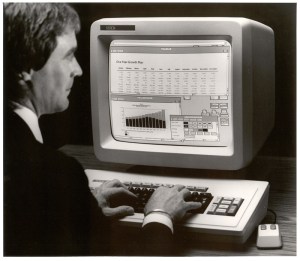
One experience with a new, top-secret, computer was about to change all that.
I ended up getting to use a new computer from an unidentified company. One night after my shift, a fellow STO dragged me back to Upson Hall and took me into a locked room in the basement. There I was able to see and use a new computer. It was a wooden box attached to a wall with an actual chain. It had a mouse, which used on the Xerox and Sun workstations. It had a bitmap screen like a workstation. It had an “interface” like the Xerox. There was a menu bar across the top and a desktop of files and folders. It seemed small and much more quiet than the dorm-refrigerator sized units I was used to hearing.
What was really magical about it was that it had a really easy to use painting program that we all just loved. It had a “word processor”. It was much easier to use than the Xerox which had special keys and a somewhat overloaded desktop metaphor. It crashed a lot even after a short time using it. It also started up pretty quickly. Most everything we did with it felt new and different compared to all the other computers we used.
The end of the semester and exams approached. The few times and couple of hours I had to play with this computer were exciting. In the sea of computing options, it was definitely the most exciting thing I had experienced. Perhaps being chained to the wall added to the excitement, but there was something that really resonated with us. When I try to remember the specifics, I mostly recall an emotional buzz.
My computing world was filled with diversity, and complexity, which left me unprepared for the way the world was going to change in just the next six weeks.
Superbowl
To think about Apple’s commercial, one really has think about the context of the start of the year 1984. The Orwellian dialog was omnipresent. Of course as freshman in college we had just finished our obligatory compare/contrast the dystopian messages in Animal Farm, Brave New World, and 1984 not to mention the Cold War as front and center dialog at every turn. The country emerging from recession gave us all a contrasting optimism.
At the same time, IBM was omnipresent. IBM was synonymous with computing. Sure the Charlie Chaplin ads were great, but the image of computing to almost everyone was that of the IBM mainframe (CORNELLA was located out by the Ithaca airport). While IBM was almost literally the pillar of innovation (just a couple of years later, scientists at IBM would spell IBM with Xenon atoms), there was also great deal of distrust given the tenor of the time. The thought of a globally dominant company, a computer company, was uncomfortable to those familiar with fellow Cornellian Kurt Vonnegut’s omnipresent RAMJAC.
Then the Apple commercial ran. It was truly mesmerizing (far more so to me than the Superbowl). It took me about one second to stitch together all that was going on right before my eyes.
Apple was introducing a new computer.
It was going to be a lot different from the IBM PC.
The world was not going to be like 1984.
And most importantly, the computer I had just been playing with weeks earlier was, in fact, the Apple Macintosh.
I was so excited to head back to the terminal rooms and talk about this with my fellow STOs and to use the new Apple Macintosh.
Returning
Upon returning to the terminal room in Upson, Macs had already started to replace VT100s. First just a couple and then over time, terminal access moved to an emulation program on Macs (rumor had it that the Macs were actually cheaper than terminals!).
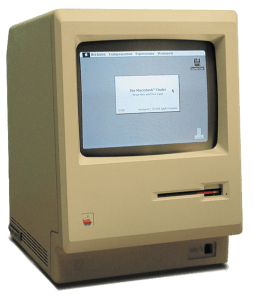
My Friday night shift was transformed. Several Macs were added to the lab. I had to institute a waiting list. Soon only the stalwarts were using the PCs. I started to see a whole new crowd on those lonely computer nights.

I saw seniors in Arts & Sciences preparing resumes and printing them on the ImageWriter (note, significantly easier to change the ribbon, which I had to do quite often every night). Those in the Greek System came by for help making signs for parties. Students discovered their talent with MacPaint pixel art and fat bits. All over campus signs changed overnight from misaligned stencils to ImageWriter printouts testing the limits of font faces per page.

I have to admit, however, I spent an inordinate amount of time attempting to recover documents that were lost to memory corruption bugs on the original MacWrite. The STOs all developed a great trouble shooting script and signs were posted with all sorts of guesses (no more than 4 fonts per document, keep documents under 5 pages, don’t use too many carriage returns). We anxiously awaited updates and students would often wait in line to update their “MacWrite disks” when word spread of an update (hey, there was no Internet download).
In short order, Macintosh swept across campus. Cornell along with many schools was part of Apple’s genius campaign on campuses. While I still had my Osborne, I was using Macintosh more often than not.
Completing College
The next couple of years saw an explosion of use of Macintosh across campus. The next incoming class saw many students purchasing a Mac at the start of college. Research funds were buying Macs. Everywhere you looked they were popping up on desks. There was even a dedicated store just off campus that sold and serviced Macs. People were changing their office furniture and layout to support using a mouse. Computer labs were being rearranged to support local printers and mice. The campus store started stocking floppy disks, which became a requirement for most every class.
Document creation had moved from typewriters and limited use of WordPerfect to near ubiquitous use of MacWrite practically by final exams that Spring. Later, Microsoft Mac Word, which proved far more robust became the standard.

The Hotel School’s business students were using Microsoft Mac Excel almost immediately.
The Chemistry department made a wholesale switch to Macintosh. The software was a huge driver of this. It is hard to explain how difficult it was to prepare a chemistry journal article before Macintosh (the department employed a full time molecular draftsman to prepare manuscripts). The introduction of ChemDraw was a turning point for publishing chemists (half my major was chemistry).
It was in the Chemistry department where I found a home for my fondness of Macintosh and an incredibly supportive faculty (especially Jon Clardy). The research group had a little of everything, including MS-DOS PCs with mice which were quite a novelty. There were also Macs with external hard drives.
I also had access to MacApp and the tools (LightSpeed Pascal) to write my own Mac software. Until then all my programming had been on PCs (and mainframes, and Unix). I had spent two summers as an intern (at Martin Marietta, the same company dBase programmer Wayne Ratliff worked!) hacking around MS-DOS writing utilities to do things that were as easy as drag and drop on a Mac or just worked with MacWrite and Mac Excel. As fun as learning K&R, C, and INT 21h was, the Macintosh was calling.

My first project was porting a giant Fortran program (Molecular Mechanics) to the Mac. Surprisingly it worked (perhaps today, equally surprising was the existence of a Fortran compiler). It cemented the lab’s view that the Macs could also be for work, not just document creation. Next up I just started exploring the visualizations available on the Mac. Programming graphics was all new to me. Programming an object-oriented event loop seemed mysterious and indirect to me compared to INT 21h or stdio.
But within a few hacking sessions (fairly novel to the chemistry department) the whole thing came together. Unlike all of the previous systems I used, the elegance of the Mac was special. I felt like the more I used it the more it all made sense. When I would bury myself in Unix systems programming it seemed more like a series of things, tricks, you needed to know. Macintosh felt like a system. As I learned more I felt like I was able to guess how new things would work. I felt like the bugs in my programs were more my bugs and not things I misunderstood.

The proof of this was that through the Spring semester my senior year I was able to write a program that visualized the periodic table of the elements using dozens of different variables. It was a way to explore periodicity of the elements. I wrote routines for an X-Y plot, bar charts, text tables, and the pièce de résistance was a 2.5-dimensional perspective of the periodic table showing a single property (commonly used to illustrate the periodic nature of electron affinity). I had to ask a lot of friends who were taking computer graphics on SGIs for help! Still, not only had I just been able to program another new OS (by then this was my 5th or 6th) but I was able to program a graphical user interface for the first time.
MacMendeleev was born.
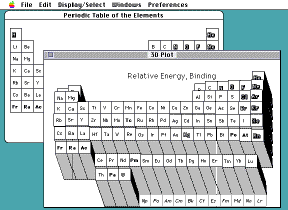
The geek in all of us has that special moment when at once you feel empowered and marvel at a system. That day in the spring of 1987 when I rendered a perspective drawing from my own code on a system that I had seen go from a chained down plywood box to ubiquity across campus was magical. Even my final report for the project was, to me, a work of art.
The geek in all of us has that special moment when at once you feel empowered and marvel at a system.
It wasn’t just the programming that was possible. It wasn’t just the elegance and learnability of the system. It wasn’t even the ubiquity that the Macintosh achieved on campus. It was all of those. Most of all it represented a tool that allowed me to realize some of my own potential. I was awful at Chemistry. Yet with Macintosh I was able to contribute to the department and probably showed a professor or two that in spite of my lack of actual chemistry aptitude I could do something (and dang, my lab reports looked amazing!). I was, arguably, able to learn some chemistry.
I achieved with Macintosh what became one of the most important building blocks in my education.
I’m forever thankful for the empowerment that came from using a “bicycle of the mind”.
I’m forever thankful for the empowerment that came from using a “bicycle of the mind”.
What came next
Graduate school diverged in terms of computing. We used DEC VMS, though SmallTalk was our research platform. So much of the elegance of the Macintosh OS (MacApp and Lisa before that) was much clearer to me as I studied the nuances of object-oriented programming.
I used my Macintosh II to write papers, make diagrams, and remote into the microVAX at my desk. I also used Macintosh to create a resume for Microsoft with a copy of Microsoft Word I won at an ACM conference for my work on MacMendeleev.
I also used Macintosh to create a resume for Microsoft with a copy of Microsoft Word…
When I made it to Microsoft I found a great many shared the same experience. I met folks who worked on Mac Excel and also had Macs in boxes chained to tables. I met folks who wrote some of those Macintosh programs I used in college. So many of the folks in the “Apps” team I was hired into that year grew up on that unique mixture of Mac and Unix (Microsoft used Xenix back then). We all became more than converts to MS-DOS and Windows (3.0 was being developed when I landed at Microsoft).
There’s no doubt our collective experiences contribute to the products we each work on. Wikipedia even documents the influence of MacApp on MFC (my first product contribution), which was by design (and also by design was where not to be influenced). It is wonderful to think that through tools like MFC and Visual Basic along with ubiquitous computing, Windows brought to so many young programmers that same feeling of mastery and empowerment that I felt when I first used Macintosh.
Fast-forwarding, I can’t help but think about today’s college students having grown up hacking the web but recently exposed as programmers to mobile platforms. The web to them is like the Atari was to me—programmable, understandable, and fun. The ability to take your ideas, connect them to the Internet, touch your creation, and make your own experience must feel like building a Macintosh program from scratch felt like to me. The unique combination of mastery of the system, elegance of design, and empowerment is what separates a technology from a movement.
Macintosh certainly changed my path in life…
For me, Macintosh was an early contributor to my learning, skills, and ultimately my self-confidence. Macintosh certainly changed my professional path in life. For sure, 1984 was not at all like 1984 for me.

Yes, of course I’m a PC (and definitely a Surface). Nothing contributed more to my professional life than the PC!
–Steven Sinofsky (@stevesi, stevesi@mac.com)
PS: How far have we come? Check out this Computer Chronicles from 1985 where the new Macintosh is discussed.
Dealing with “shiny objects”: tips for using both sides of your brain
 In technology product development there is always something new on the horizon—something better, faster, lighter, slicker, or just shinier. These shiny objects—technologies that are not quite products but feel like they could be the future—are the stuff that hot news stories are made of, that people will stop and ask about when they see one, or that cause a halo around a company. Balancing existing products and minding the business while developing wildly new products is always the biggest challenge facing established organizations. It is also a big challenge for each of us when we consider all we have to get done in the near term.
In technology product development there is always something new on the horizon—something better, faster, lighter, slicker, or just shinier. These shiny objects—technologies that are not quite products but feel like they could be the future—are the stuff that hot news stories are made of, that people will stop and ask about when they see one, or that cause a halo around a company. Balancing existing products and minding the business while developing wildly new products is always the biggest challenge facing established organizations. It is also a big challenge for each of us when we consider all we have to get done in the near term.
Recently there have been a lot of stories about companies doing “crazy” things while at the same time there are stories about the challenges in the “core” business. Google is famous for having very forward looking projects–internet balloons, driverless cars, connected glasses–while at the same time there is a huge transition going on in mobile computing that might impact the web search business that is so phenomenally successful.
When things are going well for a company, shiny objects are hailed as forward-looking innovations from an industry leader. Impatience dominates as people want to see these products in market sooner. When things are not going well for the company, perception radically shifts to one questioning focus on the “core business”. Impatience dominates as people want to see the company stay more in tuned to the challenges in the near term.
In practice, any organization of size engaged in any business with traction needs to be out there firing on all cylinders with the current business while also innovating radically different ideas. Finding a balance in resource allocation, company organization, and both internal and external communications is always going to be a challenge.
Research on the topic led to the work The Ambidextrous Organization, by Charles A. O’Reilly III and Michael L. Tushman. In this work, the authors researched how companies can innovate while maintaining their existing work. As you can imagine, there’s no simple formula or rule and context matters a great deal. The original paper from 2004 has some great case studies worth a read. One of the key learnings is that organizations can be ambidextrous, even if individuals are not always able to deliver on the current business while executing on a new venture at the same time.
In fact doing both at once is almost impossible—both are full time jobs, both require immense focus and dedication, and in reality there are different skills. From my perspective the real “trick” to being ambidextrous is to realize that an organization as whole (the company) needs efforts across a full spectrum of product development innovations. There’s a need for research labs doing pioneering work in deep technical challenges using their depth knowledge and a science-based approach. There’s a need for product development organizations to push the boundaries on existing technology bases in developing innovative new features. And there’s a need for product development organizations to themselves pioneer new products, line extensions or new lines, using their skills in bringing technology to market.
If you consider that a company is a portfolio of efforts and that different skills are required to make different advances, the notion that companies can lose focus or get distracted by shiny objects does not really make a lot of sense. It is certainly the case that one person can be drawn to be too focused on new things and not leave time for their responsibilities. The more senior a person, all the way up to a technology CEO, the more they wear many hats, context shift, and are generally required to focus on many things as a basic job description.
If you’re an engineer working on your company’s bread and butter there’s probably a time when you’ve been frustrated with the company’s shiny objects. When things are going well, the folks working on those look like they are creating the future. When things are not going well, you might think the company is squandering resources. Realizing that much of those observations are just perception, you can feel fortunate that your company leadership is working hard to be ambidextrous. You can do the same for your own growth and learning. Rather than get frustrated, get learning.
Here are a few things you can do yourself to exercise the creative side of your brain if you’re feeling a bit jealous of those shiny projects while you focus on getting the next money maker out the door:
Use competitive products. Nothing can make you think differently about your own work than to live and breathe your main competitor’s product. While not everyone can do this (if you work on jet engines that is a challenge), but do the very best you can to see your competitor’s products from the perspective of their customers. Products can have different conceptual models or approaches and thinking outside of your own box is the first step in being ambidextrous—because sometimes a breakthrough in your product is simply a recognition that your competitor has a better way to approach things.
Attend conferences outside your core expertise. Go to a conference that is in your domain but stay away from the sessions about your company and products. Much like using competitive products you can learn a great deal by attending a deep technical conference and freeing yourself from your own technologies and products. Don’t just stick to your own domain. You can expand your mind by shifting to another technical silo. If you’re a backend developer then go to a games conference and learn the techniques of storyboarding and animation for a change. If you’re industry has a tradeshow then see if you can explore that, but again shy away from your core expertise and expand your perspective. Of course whenever you attend a conference, you owe it to your team and your company to share the learning in some structured way—blog posts internally, team meetings, email, etc.
Explore on your own. Engineers are famous for their garages, basements, and spare rooms. These are where some of the most amazing innovations in technology were created. Use that space to be systematic in how you explore and learn. Build something. Work your way through an online course or book on a topic you don’t know about. Be multi-disciplinary about how you think about things by pulling in ideas from other fields as you explore. What is so amazing about today’s technology space is just how much can be done creatively in software by a single person.
Write and share. If you have the start of creative ideas, then write them down and share them. The essence of academic research boils down to sharing ideas and so borrow a page from them. Writing will help you to make connections with people who share your passion but will also help you to expand your own perspective on topics. Writing is hard and does not come naturally for everyone, but if you’re trying to think outside the box it is a great tool.
Keep a list. One tool I’ve found helpful is to keep a list of all the “interesting things” outside of my day to day to responsibilities. New products and technologies pop up all the time. A list gives you a tool you see potential trends and patterns from your perspective. Go back to the list routinely and remind yourself to follow up on a “sighting” and check back to see how it is evolving. Maybe you should use one of the above to devote more time to it?
Where do you find the time? First and foremost, all large companies allow for time for professional development. It is a matter of working with your manager to best use that time. After that, how you grow in your career and skillsets is a function of the time you’re willing to put in. The investment in time is one that pays back.
Back in the 1980’s the buzz in the exercise world was cross-training. Companies, like shoes, always have specialists working deeply across the spectrum of current products to crazy new ideas. No company can be totally focused on one place—that’s just not healthy. As an individual you should consider how to cross-train your brain when it comes to your own skills. It doesn’t mean you’ll be expert at everything, but you can think beyond that of a specialist.
Healthy companies have a balance of existing products, new products, and wild/breakthrough ideas yet to be products. It might be that some think a company isn’t focused if it is working on projects that seem far afield, but that often just depends on the context at the time. As an engineer you should consider your own growth and training in a similar way. Even though there is always more work to do than time, you owe it to your shareholders (you!) to exercise your brain by exploring new technologies and approaches, even while deadlines loom.
-Steven Sinofsky
Feel free to connect on LinkedIn or follow @stevesi on twitter.
Delegating or micromanaging, threading the needle
 Micromanagement can be a reflection of a manager’s feedback and concerns about progress. Empowerment can create a detached or worried manager. Threading the needle between delegation and micromanagement is central to the relationship between a manager and a report. How do you balance this as either a manager or employee?
Micromanagement can be a reflection of a manager’s feedback and concerns about progress. Empowerment can create a detached or worried manager. Threading the needle between delegation and micromanagement is central to the relationship between a manager and a report. How do you balance this as either a manager or employee?
Be sure to check out the poll results at the end of this post on the topic of why meetings are so ineffective. This week’s poll is https://www.surveymonkey.com/s/NTSCCCK.
A first year MBA student made the following observation:
High-performing people generally want autonomy to get things done without anyone micromanaging them. At the same time, as a midlevel manager, I’ve often had someone above me who’s holding me accountable for whatever my direct reports are working on.
I’m struggling to find the right balance between giving people their autonomy while also asking sufficient questions to get the detail I need in order to feel comfortable with how things are going.
This situation is not uncommon and represents a most fundamental challenge in any management hierarchy. The situation boils down to a manager feeling accountable, employees wanting the freedom to do the work the best way they know how, and those outside this context assuming all is functioning well.
Here are 5 suggestions for improving the delegation process and avoiding the label of micromanagement:
- Delegate the problem, don’t solve it. The first sign of micromanaging is when delegating a project you also delegate the specifics of the solution. While that makes sense in some fields, in creative or information work, being told up front the steps to follow makes one feel like a vendor and not a partner in the work. This type of delegation doesn’t have the feeling that it enhances skills or career. If the steps are well-known then perhaps there is a different view of the problem or delegation that will better suit a creative member of the team.
- Share experiences, don’t instruct. As the work progresses there’s a chance that the manager will see a pattern or similar situation arise. There’s a good chance the way that experience is communicated can come across as either “sage sharing of experiences” or “more micromanaging”. If there are experiences to share then share the story and allow the learning to take place by allegory and not turn the learning into “just do these steps”.
- Listen to progress, don’t review it. Just as managers should be delegating the problem, not the steps to solving it, when it comes time for progress to be reported it is best to let folks report on the progress the way it works best. Micromanaging can also take the form of being specific about how progress should be reported or “summoning” people to review the progress. If folks have been asked to take on a project, make sure they have the freedom to define the mechanics of the project as well.
- Provide feedback, don’t course correct. Things might not be always going as well as everyone wants and when that happens managers can sometimes slip into “gotta get this fixed” mode. This type of course correction can remove many of the downstream benefits of delegation and turn into a big negative for folks. It not only disempowers, but demotivates. When things aren’t going well, the time is right for honest feedback and a two-way dialog.
- Communicate serendipitously, don’t impede progress. All projects have more work and less time than they need. One way to reduce the amount of time available to make forward progress is for management to call for reviews or updates in a formal manner (meetings, written reports). This type of communication can slow things down—the preparation, the review, the general stand-down while these work products are created. If management is concerned about how things are going, then make it a point of finding the balance between serendipitous contact with the team and bugging them too much.
Above all, treat folks as you would like to be treated and validate that approach. If you are the type of person that is eager to request and receive feedback then chances are you won’t see an eager manager as micromanaging you. But if you are the type of person that likes some elbow room and your manager is the eager provider of feedback, then that mismatch is likely to be perceived as micromanagement rather than empowering delegation.
The simple solution to this potential dilemma is to communicate about these stylistic expectations before the work really starts. Even if you’ve worked together for a while and have a rhythm, a new project might come with new approaches for working together.
Delegation can take the form of management asking for work from the team or it can take the form of “we’re all in this together”. The question to ask yourself is if you delegate work so you’re part of “us” or “them”?
What are some tools you use for effective delegation? Check out the poll – https://www.surveymonkey.com/s/NTSCCCK.
–Steven Sinofsky
Thanks for everyone that responded to our survey for “Using meetings to be more effective”. In this survey, we hoped to learn together about the tools and characteristics that make meeting successful.
Here are the results:
- About half of our most recent meetings include a phone bridge, with about one third connecting via Voice over IP (i.e. Skype)
- In about one in six meetings, at least one person joins via a cell phone
- About half of our meetings take advantage of screen sharing and about half involve PowerPoint, though only in about one third was a projector used
- When asked about whether our last meeting was a success, on average (mean and median) we “neither agree nor disagree” that it was a success
In looking at drivers for what made us rate a meeting a success, there were some interesting findings:
- Regarding technologies, of the technologies queried (phone, cell, VoIP, screen sharing, PowerPoint, projector, and meeting software), only the use of a projector had a statistically significant impact on our success rating. However, meetings with a projector ranked half a point lower on a five point scale, than those without projectors
- Interestingly, presenters rated meetings with projectors lower than members of the audience, with a difference of about a half point, it’s worth noting this was not correlated with slideshow software like PowerPoint
- Of the tips for success discussed, “a fully understood context” drove the success factor up a third-point , and a “concise” meeting (brevity) drove success up nearly a half-point.
- Interestingly, presenters rated meetings with “a fully understood context” higher than members of the audience
Bottom Line:
Modern meetings leverage online tools like to get everyone on the same page, though care should be taken during in-person meetings to not let the audio/visuals detract from your message as a presenter. Taking time before and during the meeting to create a shared sense of context and keeping your message concise seem to drive the best outcomes for everyone, presenter and audience alike.
Thanks, Cameron
# # # # #
Applying the benefits of Yoga to product development and vice versa
 The physiological benefits of exercise are well known, and regular exercise can also bring benefit to your work. Any exercise will do of course, starting with just walking as often as possible. The summer brings with it opportunities for broad ranges of outdoor activities. Almost all health studies point to the need for rigorous exercise to be a regular part of your routine in order to achieve the maximum benefit for health and work productivity.
The physiological benefits of exercise are well known, and regular exercise can also bring benefit to your work. Any exercise will do of course, starting with just walking as often as possible. The summer brings with it opportunities for broad ranges of outdoor activities. Almost all health studies point to the need for rigorous exercise to be a regular part of your routine in order to achieve the maximum benefit for health and work productivity.
Please be sure to take the survey on exercise and productivity found here.
Yoga is an especially good exercise for those that value a routine (or require a routine to better stick to a program). Rain or shine, hot or cold, day or night, yoga is always there. Centuries old, the health benefits of yoga are highly regarded by practitioners around the world and many religions, psychologists and biologists agree that taking time to rest, focus and center is an important part of human productivity. In the US, a variety of styles of yoga performed in room heated anywhere from 90 to 105+ degrees F has become increasingly popular. The heat provides additional benefits and an extra level of challenge as well. If you value routine, Bikram yoga is especially good since it is precisely the same every class.
Yoga’s history is rooted in meditation and ritual and for many today the spiritual aspect is the high order bit. For others, the spiritual side of yoga is appreciated in the context of other beliefs or just your daily personal life. Even the aum (om) sign or chant carries with it a deep ritual meaning for some as well as a more personally defined spiritual meaning for others.
I was asked about practicing yoga at the All Things D conference by Katie Boehret and she captured a few seconds on the KatieCam. I wanted to elaborate on the benefits by using 5 sayings/expressions that I’ve learned from many of the wonderful yoga instructors I’ve had over the years.
- Be present. At the start of most yoga classes, instructors will remind everyone to “be present”. That means to set aside all that is going on outside the class and to spend the next 90 minutes present in the room, on your mat, and in the practice–no electronics or distractions. How often at work do things outside the context of what you’re working on interfere with the work—did you bring the challenges from the previous meeting into the next meeting or is something going on outside work showing through how you are at work? Take the time at the start of a day, as a meeting starts, or while coding to be present in what you’re doing.
- All that matters is on your mat. Yoga is not a competitive sport.* Yoga is not a race—you can’t finish first, you can’t be faster or lift more. Yoga is about making sure you are focused on what you can do best and that you are doing your best at that. So when practicing, making sure you’re focused on what you are supposed to be focused on is a path to success. The workplace isn’t a competitive sport either. In the workplace, this can mean doing the work you’re supposed to be doing and assuming those around you are doing the same.
- Drishti. Focus is a big part of Yoga. If you lose focus during some balancing pose you probably just fall over. Or if you lose focus on your breathing you very quickly hyperventilate and get exhausted or just turn blue! Drishti is a Sanskrit word that means focus, but a distinct form of focus. You focus but not so intensely that you lose sight of all around you. Rather it is the opposite, where you focus but with a full awareness of the rest of your mat and body. So rather than staring at a dot on the wall in front of you, you gaze at the dot but focus on breathing, your balance, and more. In software projects it is important to be focused—but if you’re too head’s down you miss important connections to what is going on around you or around the code. The full definition of drishti means vision, point of view, or even intelligence and wisdom. It also means being equal in all directions you look and maintaining self-control. A lot of collaboration in product development can be summed up in drishti.
- Yoga practice is not yoga perfect. Many “Type A” personalities find a way to compete in exercise—running times, weight lifted, miles biked and so on. Yoga is designed for life long exercise. There’s always more to do or a way to connect one pose to another you never thought of. Any yogi who has browsed the advanced videos online is quickly humbled by what they cannot do. During those difficult postures, yoga instructors always remind the class that yoga is a practice and it is not called yoga perfect. You do the best you can with the body you have that day, and you commit to practicing the next day. Product development is like this as well—we often say the enemy of the good is the perfect. No product is perfect, but the least perfect product is one that doesn’t ship. Shipping gives you the right to come back the time with improvements and a better product based on what you learned as a team.
- How you do anything is how you do everything. In class, especially when it is hot, you can easily find a way to slack off or find a way to do a pose that might look like you’re posing but in reality you are missing the benefits. Of course you’re just cheating yourself. When an instructor sees this you might hear the most gentle of reminders, “how you do anything is how you do everything”. Put simply this just means that if you are willing to take a shortcut on one pose then where else in life (or in your product) are you willing to take a shortcut. If you’re willing to cheat yourself out of your best efforts, then won’t you cheat others? Always put forth your best efforts, even when you’re pushed to the point of thinking you can’t possibly continue.
That’s a yoga perspective on exercise and well-being that are critical parts of contributing to your work, your project, and your team. While yoga has been my personal approach, what is really important is that you find your approach to physical and mental well-being. Whatever that might be is sure to be a critical tool in your own success.
What do you do to maintain your physical as well as spiritual health in the workplace? What lessons do you bring back to the workplace from your avocation?
Namaste,
Steven Sinofsky
*While controversial there do exist yoga competitions — check this out.
Defining your career path: journey or destination
 When asked about career path, some are quick to say things like “VP of … in 10 years” or “world’s expert in ….” Others might say “work in engineering, sales, management, and ….” Or maybe some would say “start 3 companies…IPO.” Taking a step back it is worth putting a framework around how to think about the experiences you build over time. Climbing the corporate or businesses ladders aren’t the only ways to think about careers, even though they occupy much of the energy devoted to talking about careers. Do you view your career as a journey or a destination?
When asked about career path, some are quick to say things like “VP of … in 10 years” or “world’s expert in ….” Others might say “work in engineering, sales, management, and ….” Or maybe some would say “start 3 companies…IPO.” Taking a step back it is worth putting a framework around how to think about the experiences you build over time. Climbing the corporate or businesses ladders aren’t the only ways to think about careers, even though they occupy much of the energy devoted to talking about careers. Do you view your career as a journey or a destination?
Please be sure to see the three quick questions poll at the end of this post along with results from the last poll and take this post’s survey on career paths here.
For some, a professional career is a destination. From the very start, the goal is to achieve some level of proficiency or stature in your chosen field of work. The destination can be a role, a company, a level of achievement, or other specific and measurable goal.
For others, a professional career is a journey. From the very start, the goal is to experience work from a variety of perspectives in your field and adjacent field. The journey can be different companies or organizations within a big company, job types, geographies, or other varied aspects of your profession.
Destination and journey are different ways to look at career progression. While it is tempting to think of these as mutually exclusive or as a one-time choice, the reality is (as you can expect) a little less clear. Even so, you want to know not just the next step but the reasons behind next steps and how they contribute to a career path.
Destination
Many start careers with a goal of working their way “up” the chain. Going to manager, to general manager or director, to vice president, and more (gaining rank, earning tenure, making partner, etc.) defines progress. This might be exactly right for you. Setting your sights on specific and measurable milestones fits with how many view career progression.
Progression up the corporate ladder is not the only way to about your destination. In planning your next steps, one might consider two views of a destination-oriented path:
- Org leader. As an org leader you follow the path of moving “up”. While your path might involve moving laterally at times, you focus on meeting the objectives as defined by the organization for what skills and experiences enable you to move through the milestones of management.
- Domain expert. As a domain expert you follow the path of being the leader in your area in your company. For many technologists, this is ultimately where the highest satisfaction comes from. You know the ins and outs of a technology, system, or product better than anyone. You do this through years of experience and effort.
Focusing on your destination is not for everyone. This is not just a statement of skills that not everyone might have, but time and place play a role in achieving this type of goal. In most large organizations there is a fraction of the total team at “top” positions. For every VP there might be 100 or even 1000 other employees. Similarly, for every top domain expert, there may be 100 or 1000 other employees not as far along in their domain knowledge.
A destination goal is a long term play and means that during your path you will have periods that feel like you are not moving up, but that should not stop you from moving forward. You might need to take a step left or right sometimes to keep moving up. Most of all, never think that for you to move up, someone needs to move down. Most of the time with a destination oriented career your next steps are visible to you and the organization, and patience and timing play important parts of progression.
When you are set on a destination you also want to be prepared to manage through changes in the landscape.
As an org leader you are ultimately accountable for large projects or budgets, and the people that deliver on those commitments. Sometimes things don’t go as hoped and as an org leader you have to step up and accept responsibility. These become the key learning moments in your career progression.
As a domain expert, technologies change and paradigms change. The long-term domain experts are expert not in the specifics but in the solutions. As an amazing programmer you want to reinvent yourself as new languages and tools emerge. Leading the team through these discontinuities are the key learning moments in your career progression.
Journey
Many people start their careers knowing that the world is a big place waiting to be explored. They see the world through the lens of an adventurer or explorer. Going thoughtfully from one role to another or one organization to another fills your expectations of progressing through your career, or life. Setting your sites on a collection of experiences that you wish to have is the measurable way of managing your career.
Variety is not easy to measure and there is a fine line between variety and job-hopping. If the journey is your goal you want to have a clear understanding of how you intend to assemble a collection of experiences. You will move thoughtfully through these experiences and time your moves based on achieving some level of proficiency, satisfaction, and success.
In planning your journey, you might consider two views of a journey-oriented career path:
- Breadth leader. With breadth leader, you aim to have very different roles over time. You might choose to move between sales, marketing, business, or development in a product area you know and love. You might choose to move to different parts of the world to experience sales and marketing with a local flavor. You might choose to work on a variety of products within a large organization. You might even move from company to company. All of these broaden your experiences, and if you’re focused on the journey you will meet different people, learn from different perspectives, and experience your career from a variety of vantage points, absorbing these along the way as you grow and mature. Along the way you will be in a position to lead more as you gain experiences.
- Field expert. As a field expert, you collect experiences much like a domain expert but you establish breadth expertise by looking at your domain from a 360 degree view. You might be a technical expert with experience implementing such as system at different companies or you might have engineered similar systems from the ground up several times in different contexts. You seek to grow and progress through your career with depth experiences explored from different angles.
A journey career is not for everyone. You substitute the certainty of goals such as ladder levels or career stages, job titles, and pay grades with more substantial transitions. With a journey career your next steps are much more about what you seek out to achieve and less about what “comes next”. As with the explorers from another era, a journey career is driven from within and by your own desires.
On your journey, the transitions are key times you take action and plan on your next steps. Your deliberate next step makes all the difference when you reflect back on your path. Did your next step look “random” or did you have a clear rationale for choosing what you did? Think about how you might explain your steps to someone looking at your resume/CV as you explore the step after the next one.
When you choose your next step, you need to be prepared for a lot of change. You will work for new people, work with new people, and have different processes. You will need to adapt and conform. Things you thought you knew might not be right in the new context. On the other hand you will meet all sorts of new people and experience new ways of approaching the problems and challenges of business. Down the road when you have to define a process for a group, you have all your experiences and contexts to draw from to avoid repeating mistakes you might have experienced.
With a breadth leader path you might feel like you really jumped in the deep end at one transition. You might feel like you made a big mistake, going to work in a far-away place for example. Stick with it. Live through it. Adapt and grow. You will become more valuable to the team as a whole when you can call upon the collected learning. These are the learning moments on your journey.
As a field expert, you might find yourself in a familiar domain but without the resources you became accustomed to at your last role. You might wish you could call on that trusted associate or allocate budget in a way you did before, but these are not available to you. You will need to blaze a new trail or creatively solve the problem using the experience you have but applied differently. Using your domain knowledge and experience in this new context is how you learn as a field expert.
Adapting
You might reach a stage in your career where you want to settle down after many a journey. You might similarly reach a stage where it is time to explore new domains, new organizations, or just different perspectives. In other words you might find a stage in your career where the other of journey or destination becomes your new goal. Resetting your approach can be part of the journey of life.
Of course both paths have room to grow your salary and responsibility. While destination roles have high visibility in terms of material benefits, most organizations strive to have material benefits available for a broad array of people and assignments.
Keeping in mind your path and where you see the moves in your career will help you to have much more informed discussions with your managers and mentors. As a manager (or mentor), helping the members of the team to see their own desires and wishes will assist in coaching them through transitions.
If there is one piece of advice that transcends the description of your path, it is that no matter where you intend to go, the most important thing is to be excellent at what you are currently doing. When you’re doing excellent work, you create alternatives for yourself and open doors to new opportunities and paths.
–Steven Sinofsky
Three quick questions poll by Cameron
In the “Being a Leader…” post we asked three questions about your manager’s behavior and your empowerment/productivity. We had a great response from this popular post, here is what we learned together:
- Over half of you (54%) report that your manager “asks me to solve vaguely defined problems”, while only 14% report that their manager “spells out expectations in detail”
- Nearly half (48%) said that their manager “mostly edits” when reviewing their work and 45% said their manager “adds works without taking work away”
- There is nearly a 10% difference in the % of managers that provide “feedback quickly”(43%) vs. managers that provide “thoughtful, thorough feedback” (34%)
Next, we wanted to look at the relationship between your managers’ traits and your level of productivity and empowerment, both of which you ranked on a scale of 1-5, where 1 is low and 5 is high. The results were interesting:
- Those of you with managers that “mostly edit” when reviewing your work were about a point lower on the empowerment scale
- Those of you with managers that provided “thoughtful, thorough feedback” were about a point higher on the empowerment scale, but on average a half point lower on the productive scale
- Similarly, those of you with managers that use “delegation as a way to give others authority to make decisions” are a half point higher on the empowerment scale, but a half point lower on the productive scale.
- Those of you who had managers that “add work without taking work away” have a half point higher productivity
Bottom line: A consistent theme was that quality and quantity can be a trade-off, in leadership and in our deliverables. Often having both can prove difficult.
Disclaimer: As a caveat, it’s worth noting the subjective nature of these questions, and the potential bias of people taking this survey—those who likely have an interest in being an effective leader themselves.
Take this post’s survey on career paths here. Results reported with the next post. Thank you!
–Cameron





